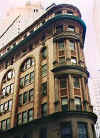 |
New York Architecture Images- Lower Manhattan DELMONICO’S Landmark |
||||||
|
architect |
James Brown Lord | ||||||
|
location |
56 Beaver Street at South William Street. | ||||||
|
date |
1891 | ||||||
|
style |
Beaux-Arts | ||||||
|
construction |
brick | ||||||
|
type |
Restaurant | ||||||
|
|
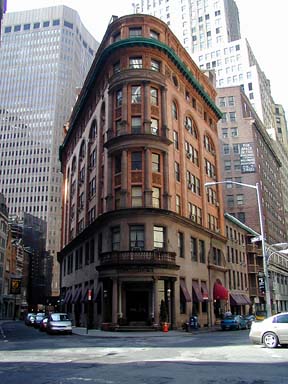 |
||||||
|
images |
 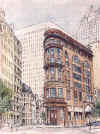 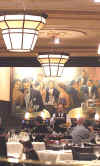 |
||||||
|
|
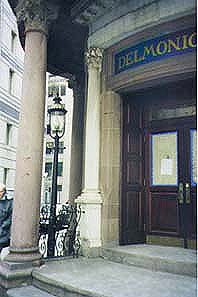 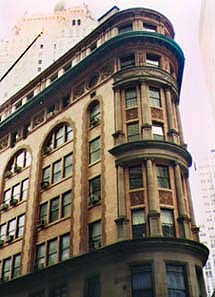 |
||||||
|
notes |
In
1825 a newly arrived nephew of Lewis Del Monico opened a small restaurant
next to his uncle's downtown candy store. Over the years the two Swiss
immigrants operated Delmonico restaurants at seven sites, venturing as far
uptown as Fifth Avenue and 26th Street.
Delmonico's reputation for fine and fashionable dining grew with its movement up the island, but Uncle Lewis always favored his downtown restaurant. After he died, his nephew demolished the building and hired James Brown Lord to design this eight-story Delmonico's in 1891. The marble portal behind the front columns was reportedly brought from Pompei by the Del Monicos. Famous diners over the years were Charles Dickens, Mark Twain, and a series of American presidents. The building has recently been restored and the upper floors turned into residences. The restaurant has re-opened as a Continental steak house, featuring some of the dishes from the original restaurant, including Lobster Newburg, a Delmonico's creation. John (Giovanni) and Peter (Pietro) Delmonico opened a wine a pastry shop in New York in 1827. They were so successful they had to call to their nephew in Switzerland. Lorenzo Delmonico came to help. Eventually, Lorenzo's brothers also came to New York to help with the embellishment of the business. Lorenzo, supervised the management and personally went to the Washington Street Market to hand pick the necessities for the restaurant. The family set up a 20 acre farm in Brooklyn, to insure them the harvest of the most freshest fruits and vegetable possible. When another Delmonico's was opened at 14th St. and 5th Ave. then President, Abraham Lincoln was one of Lorenzo's diners. He was so impressed by the Delmonico's chefs creations that he called Lorenzo over to his table to tell him so. It was because of Lorenzo's conversation with shipping magnate Charles Wenberg that one of Delmonico's most famous dishes was created, Lobster Newburg. Originally called Lobster Wenberg the dish was renamed Newburg after the shipping magnate became enthralled in a fist fight and was escorted out of the restaurant. Another creation from the chefs of Delmonico's was Baked Alaska in honor of the newly purchased Alaska. It was described as "a cake of frozen cream in a blanket of hot golden meringue". The original pastry shop burned down in 1835, the Delmonico's brothers reopened a new restaurant with a three story cafe, complete with a grand ballroom. There was also a private dining room and patrons selected their viands from a seven page menu. The wine menu listed 62 different imported wines. Diners were intrigued by this menu which was also offered in French and English. Delmonico's became a must visit for foreign as well as the native elite of the era. By 1876 there were four Delmonico Restaurants enhancing New Yorks culture. Some other patrons of Delmonico's included, Charles Louis Napoleon, Oscar Wilde, a famous dinner in 1868 for Charles Dickens, Walter Scott, Queen Victoria and her eldest son, the Prince of Wales. Jenny Lind ate there every night after her show. A millionaire of the time, August Belmont whose wine bill alone was estimated at $20,000 dollars a month, badgered Lorenzo into a bet with three of his friends to serve the best dinner in New York no matter what the expense. Lorenzo was in a bind because he would have to have one chef create all three meals for each man. The bet ended in a draw but truffled ice cream which later became a must at every posh restaurant in New York was born at one of those dinners. Another frequent visitor to Delmonico's was Diamond Jim Brady usually escorted by Lillian Russell. It was because of Ms. Russell's overcoming beauty that Oscar Tschirky applied for a job at Delmonico's. He wanted to serve Ms. Russell. Of course, his ambition excelled from Delmonico's to becoming chef at The Waldorf where in 1893 "Oscar of the Waldorf" introduced Waldorf Salad; "a salad made with chopped apples, walnuts, and mayonnaise". Hot Dogs and Haute Cuisine New York Public Library Serves Exhibition on the History of Dining in New York
New York Eats Out recounts New York’s dining history from the rise to prominence of Delmonico’s in the mid-19th century through the development in the early 1960s of a new style of restaurant that emphasized quality American cuisine. The exhibition starts with a section on Delmonico’s, and then is organized by “High-style Dining” and “Popular Dining,” with each style broken into two parts, “19th Century to Prohibition” and “Prohibition to 1960s.” Other sections of the exhibition look at “Street Vendors,” “Automats,” and “The World’s Fair, 1939-40.” A coda to the exhibition focuses on Windows on the World, which, situated dramatically atop the World Trade Center, was the realization of a grand experiment in urban dining and a significant loss in the wake of the September 11 attack.
Delmonico’s and High-style Dining, 19th Century to Prohibition
For almost a century, the standard-bearer of grand dining establishments was Delmonico’s. Opened on William Street as a confectioner’s shop in 1827, Delmonico’s was New York’s (and the country’s) first real restaurant and also a gathering place for high society. New York Eats Out includes photographs and prints depicting the lavish restaurant in several of its various locations. Also featured is a menu from a gala ball honoring the Prince of Wales, which was catered by Delmonico’s at the Academy of Music. For ambitious cooks there is The Epicurean, an 1894 book by the restaurant’s chef, with 4,000 recipes. Like many high-style restaurants, Delmonico’s could not survive Prohibition and finally closed its last location, at Fifth Avenue and 44th Street, in 1923. Other high-style restaurants of the same era included Café Martin, Sherry’s, the Waldorf-Astoria, and the Astor, many of which were established and staffed by former Delmonico’s employees. Special banquets held almost every night of the year were a mainstay of these establishments, and many of the menus for these events are on view. For example, the anniversary dinner of the St. Nicholas Society at the Metropolitan Hotel, December 6, 1856, featured among its many menu choices: green turtle soup; boiled salmon with lobster sauce; saddle of mutton; roast partridge with cream sauce; boned pig; terreen (sic) of goose liver with jelly; Santa Claus pudding; ornamented Charlotte Russe; ornamented rum punch slices; and fancy China soufflés.
Popular Dining, 19th Century to Prohibition
Street Vendors
Then, as today, New Yorkers in a hurry or on a budget could choose from a plentiful assortment of street-cart fare. A valuable collection of street scenes photographed by Percy Loomis Sperr on behalf of the Library from the 1920s to the 1940s provides views of vendors selling such items as candy, roast sweet potatoes, coconut milk, and pretzels. On the Lower East Side, a hot-dog vendor’s display read: “Isidore’s Hot Frankfurters on a Roll with Sauerkraut. A Nickel Meal Served Tastefully,” and a clam vendor in Harlem dealt his fare from a cart shaped and decorated like a boat. The
World’s Fair, 1939-40
High-style Dining, Prohibition to 1960s The recovery of fine dining culture after Prohibition was dampened by the Depression and wartime austerity. Still, two of the toniest restaurants in the city, the “21” Club and the Colony, emerged from the speakeasies of the Jazz Age. The “21” Club’s food is represented in a dinner menu from 1947, featuring among the entrée selections Sirloin Steak Braisé Bourguignonne Nouilles and Pigeon Desossé Farçie Souvaroff. Its status as a hangout for the city’s movers and shakers is documented in photographs of such celebrities as Zsa Zsa Gabor from the 1940s.
Le Pavillon spawned notable offshoots including La Côte Basque, La Grenouille, and La Caravelle, and the menus on view from these establishments show the French fare that served as the basis of fine dining in the middle of the century. In the 1950s, Joseph Baum, an executive with Restaurant Associates, pioneered a new type of restaurant which demonstrated that American cuisine, in a modern setting, could be every bit as fashionable and good as French cuisine. Menus and photographs represent some of Baum’s establishments, notably The Four Seasons. Among the items related to the esteemed culinary spot is the menu for President John F. Kennedy’s 45th Birthday Dinner, held at the restaurant May 19, 1962.
Popular Dining, Prohibition to 1960s Coda:
Windows on the World |
||||||